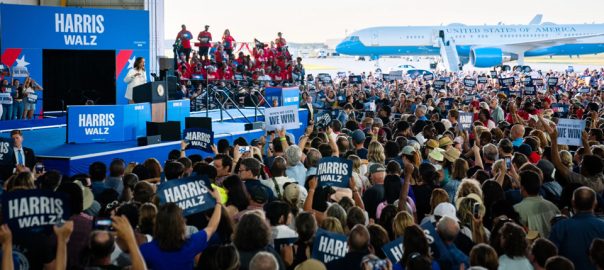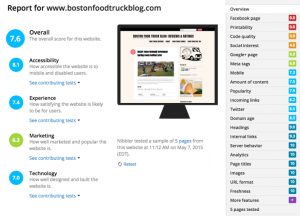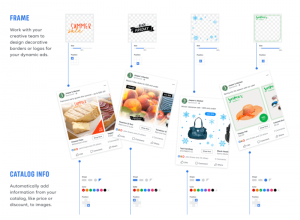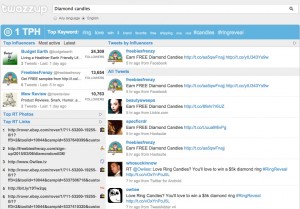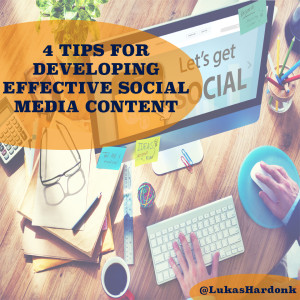TikTok’s blazing UX makes Trump’s lies spread faster than ever
Trump told a lie about Kamala Harris. And TikTok is still spreading it with abandon.
The race between Vice President Kamala Harris and former President Donald Trump has its first controversy over misinformation.
But rather than faked images that push a false narrative, it’s a false narrative claiming real images are faked. After about 15,000 people attended Harris’s rally with her running mate Minnesota Governor Tim Walz last week at an airplane hangar at Detroit Metro Airport, Trump falsely claimed on his social network Truth Social Sunday that images from the rally were enhanced using generative AI to make the crowd seem larger than it really was. Or as Trump put it, “she ‘A.I.’d’ it.”
“Has anyone noticed that Kamala CHEATED at the airport?” Trump wrote in his Truth Social post. “There was nobody at the plane, and she ‘A.I.’d’ it, and showed a massive ‘crowd’ of so-called followers, BUT THEY DIDN’T EXIST!”
Trump shared an image of the Harris rally crowd on-site at the airport, with Air Force Two in the far background. A second image in the post, which zooms in on the side of the plane, does not appear to show the crowd’s reflection, which Trump and others pushing the false claim, suggest is evidence that the photo was generated using AI. However, photos from some of the 15,000 attendees at this same Detroit airport rally, as well as wire photos from agencies, disprove this assertion, documenting a crowd that fills the hangar and even spills outside of it. The plane reflection shows the hangar.
Trump’s post was reposted on Truth Social more than 11,000 times. On TikTok, some users have reposted the image as well as their own videos and photo galleries with images they claim prove the crowd for Harris wasn’t as large as it seems. One such post, which racked up more than 12 million views, also includes an obviously faked crowd image sourced to a parody X account. The post was temporarily unavailable after Fast Company reached out to TikTok about it, but was later available again.
The ease of producing and disseminating AI-generated content is a new factor for misinformation this election year, and election officials are on high alert about the role it could play. Social networks have struggled to build and enforce effective mechanisms to combat misinformation on their platforms, with one study finding how Facebook’s efforts even backfired. Already, a faked robocall earlier in the year, claiming to be from President Joe Biden in New Hampshire, attempted to trick voters into not voting in the New Hampshire primary.
TikTok’s UX is too fast to always be truthful
TikTok wasn’t nearly as popular back in 2020 as it is in the current Presidential cycle. We’re quickly learning that its UX, which rewards rapid-fire trend repetition and has been key to its success, often moves too fast to be fact-checked by experts. And it’s hard to say whether the fact-check would get the same visibility, anyway. The number of views on the TikTok post referred to in the previous paragraph have already exceeded the entire population of Pennsylvania. The challenge is quantifying what the effect of viewing a video like this might have on voters.
Meanwhile, TikTok’s guidelines specifically prohibit “misinformation or content about civic and electoral processes that may result in voter interference, disrupt the peaceful transfer of power, or lead to off-platform violence.” TikTok did not respond to a request for comment.
While something as cosmetic as crowd size might not seem to rise to the level of discouraging people from voting or disrupting the peaceful transfer of power, Trump, the first former U.S. president to be convicted of felony crimes, connected his AI accusation to false claims of election interference. Calling for Harris to be disqualified, Trump’s post showed how quickly viral misinformation can rise from meme to election-interference pronouncements from the Republican nominee himself.
“She should be disqualified because the creation of a fake image is ELECTION INTERFERENCE,” Trump wrote in his post, which was representative of his campaign rhetoric. “This is the way the Democrats win Elections, by CHEATING – And they’re even worse at the Ballot Box.”
Crowd size is a sensitive subject for Trump, who just last week compared his rally crowd size to the crowd at Martin Luther King Jr.’s “I Have a Dream” speech. Trump also spent the opening days of his administration embroiled in a controversy about the crowd size at his inauguration in 2017. Comparisons with former President Barack Obama’s inauguration crowd size went viral, and records reviewed by The Guardian found that Trump called the acting director of the National Park Service the morning after he took office and a government photographer cropped out empty spaces on the National Mall in the official photos of the inauguration to make the crowd appear to have been larger.
For its part, though, the Harris campaign doesn’t seem to be taking Trump’s false claims very seriously. Instead, it’s trolling back.
On the @KamalaHQ account on Truth Social, the campaign has posted side-by-side comparisons of Harris’s rallies with Trump’s in the same cities, while on a video showing the Detroit crowd, the campaign account wrote, “Warning: The content of this video may upset @realDonaldTrump.”
UPDATE: The post with 12 million views that is referenced in this piece has since been removed.

ABOUT THE AUTHOR
(3)
